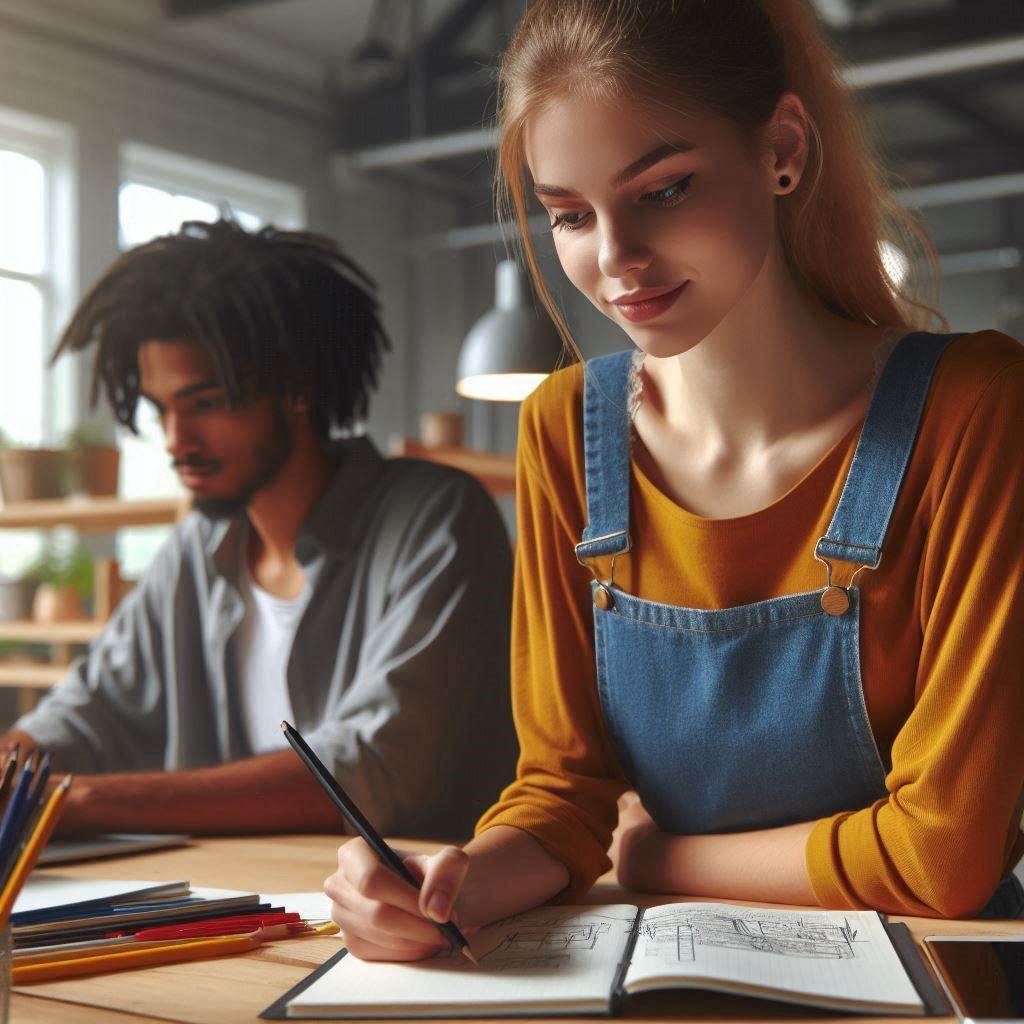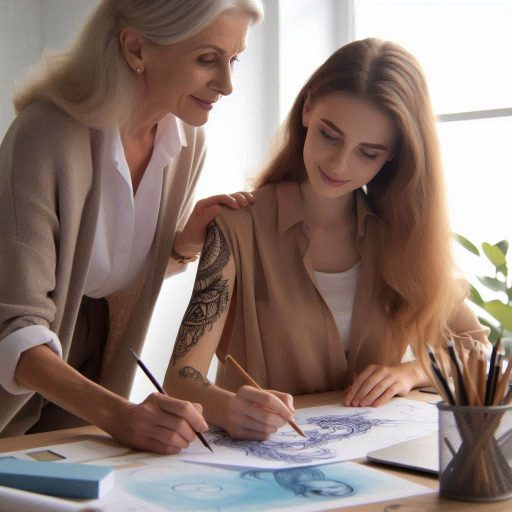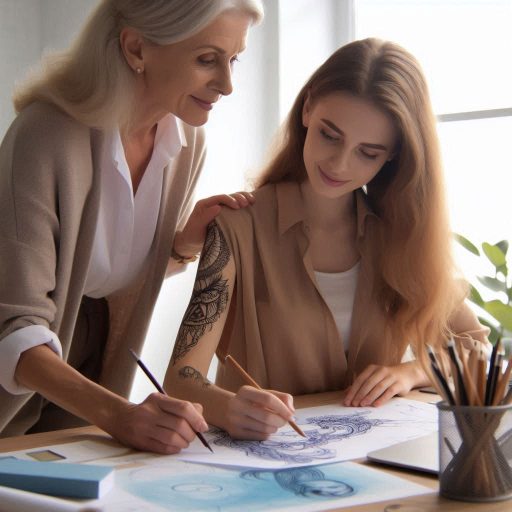Introduction
Defining Creative Blocks and Burnout
Creative blocks occur when you struggle to generate new ideas or find inspiration.
Burnout involves emotional exhaustion, often due to overwork or stress.
Both issues can significantly impact your productivity and creativity.
How Common These Issues Are
Creative blocks and burnout are widespread challenges in the professional world.
Many artists, writers, and designers face these obstacles at some point in their careers.
These problems can arise from high-pressure environments, constant deadlines, or a lack of inspiration.
Recognizing that these issues are common helps normalize the experience and encourages seeking solutions.
Importance of Addressing and Overcoming Obstacles
Addressing and overcoming creative blocks and burnout is crucial for maintaining long-term success and well-being.
Ignoring these issues can lead to prolonged stagnation and decreased job satisfaction.
By actively working to resolve them, you can restore your creative flow and prevent long-term damage to your career.
Effective strategies, such as seeking support, taking breaks, and exploring new sources of inspiration, can help you manage these challenges.
Prioritizing your mental health and creative vitality ensures sustained productivity and enhances overall job satisfaction.
Recognizing the Signs of Creative Blocks and Burnout
Common Symptoms of Creative Blocks and Burnout
Creative blocks and burnout share several common symptoms that can hinder productivity and well-being.
Creative blocks often manifest as a lack of inspiration or inability to generate new ideas.
You might experience frustration, procrastination, or a sense of being stuck in a rut.
Burnout, on the other hand, involves feelings of exhaustion, both physically and emotionally.
Symptoms include chronic fatigue, irritability, and a diminished sense of accomplishment.
Both conditions can lead to decreased motivation and a sense of detachment from your work.
Recognizing these symptoms early is crucial for addressing them effectively and maintaining your creative energy and productivity.
Examples of How These Issues May Manifest in Different Professions
Creative blocks and burnout can affect professionals in various fields in distinct ways.
For a writer, creative blocks might result in writer’s block, where ideas and words seem elusive.
They may struggle to complete projects or find themselves revising the same content repeatedly.
In contrast, a graphic designer might face burnout through repetitive tasks and long hours, leading to a lack of enthusiasm for their work.
A musician could experience creative blocks as an inability to compose or perform new material.
Similarly, an illustrator might find themselves disinterested in their art or unable to come up with new concepts.
Each profession manifests these issues uniquely, but the underlying impact on creativity and productivity is similar.
The Importance of Self-Awareness in Recognizing These Signs
Self-awareness is key to recognizing and addressing creative blocks and burnout.
Understanding your personal signs and symptoms helps you take proactive steps to manage them.
Regularly check in with yourself to assess your emotional and physical state.
Notice patterns of fatigue, frustration, or diminished enthusiasm that could indicate burnout.
Pay attention to periods when your creativity feels stifled or uninspired.
Being self-aware allows you to implement strategies for self-care and recovery before issues become overwhelming.
Techniques like taking breaks, engaging in different activities, and seeking support can help alleviate symptoms.
Prioritizing self-awareness ensures you maintain a healthy balance and sustain your creative energy over time.
Recognizing the symptoms of creative blocks and burnout is essential for effective management.
These issues can manifest differently across professions but often share common signs like fatigue and frustration.
Self-awareness plays a crucial role in identifying these symptoms early.
By being attentive to your emotional and physical well-being, you can take proactive steps to address and overcome creative challenges, ensuring sustained productivity and creativity.
Taking Breaks and Restoring Energy
Discussing the Importance of Taking Regular Breaks to Prevent Burnout
Taking regular breaks is crucial for preventing burnout and maintaining creativity.
Continuous work without rest can lead to exhaustion and decreased productivity.
Breaks help refresh your mind and body, allowing you to return to your work with renewed energy.
Short, frequent breaks can enhance focus and prevent mental fatigue.
They provide a chance to step away from your tasks and gain perspective.
Regular intervals of rest also reduce stress, helping you stay motivated and engaged.
Prioritizing breaks in your work schedule supports long-term well-being and creativity, making it essential to incorporate them into your daily routine.
Offering Tips on How to Recharge and Restore Creativity
Recharging and restoring creativity involves various strategies to rejuvenate your mind and spark inspiration.
Engage in activities outside of your usual work to gain new perspectives.
Explore hobbies, read books, or take up a new skill to stimulate creativity.
Spending time in nature can also refresh your mind and provide new ideas.
Practice mindfulness or meditation to reduce stress and clear mental clutter.
Experiment with different creative exercises or techniques to break out of routine patterns.
Additionally, seeking inspiration from art, music, or other creative fields can reignite your passion.
Regularly incorporating these practices helps maintain creativity and prevent burnout.
Encouraging Readers to Prioritize Self-Care and Mental Health in Their Daily Routine
Prioritizing self-care and mental health is vital for maintaining overall well-being and creativity.
Make self-care a regular part of your routine by setting aside time for activities that relax and rejuvenate you.
Ensure you get adequate sleep, exercise, and maintain a balanced diet.
Develop a daily routine that includes time for relaxation and personal interests.
Avoid overworking and set boundaries to protect your mental health.
Engage in activities that promote relaxation, such as reading, exercising, or spending time with loved ones.
Recognize the signs of burnout and take proactive steps to address them.
By integrating self-care into your daily life, you support your mental health and sustain your creative energy.
By taking regular breaks, recharging your creativity, and prioritizing self-care, you can effectively manage creative blocks and burnout.
These practices help you maintain a balanced and productive work life, ensuring that you stay inspired and engaged in your creative pursuits.
Regular self-care and mindful breaks are essential components of a healthy, sustainable creative routine.
Read: Building a Portfolio for Costume Design
Seeking Inspiration and New Perspectives
Strategies for Finding Inspiration and Overcoming Creative Blocks
Overcoming creative blocks requires proactive strategies and a willingness to explore new approaches.
Start by setting aside dedicated time for creativity without pressure.
Often, creative blocks arise from the stress of deadlines or expectations.
By creating a low-pressure environment, you give yourself the freedom to experiment and explore ideas.
Engage in activities that stimulate your imagination.
Reading books, watching films, or visiting art galleries can provide fresh perspectives.
Surrounding yourself with diverse forms of art and storytelling can spark new ideas and reinvigorate your creative process.
Sometimes, a change in your routine or environment can also trigger inspiration.
Another effective strategy is to break projects into smaller tasks.
Tackling a project in manageable chunks can make it feel less overwhelming.
This approach also allows you to focus on one aspect of the project at a time, reducing the likelihood of feeling stuck.
Exploring New Experiences and Exposing Oneself to Different Perspectives
Exploring new experiences and exposing yourself to different perspectives can reignite your creative spark.
Travel, even if it‘s local, can introduce you to new cultures, landscapes, and ideas.
Immersing yourself in unfamiliar environments can provide fresh inspiration and new ways of seeing the world.
Attend workshops, classes, or networking events related to your field.
Interacting with others in your industry can provide new insights and techniques.
Engaging with diverse viewpoints and skill sets can challenge your own creative habits and encourage innovative thinking.
Volunteering for projects outside your usual scope can also be beneficial.
It allows you to experiment with different styles and techniques.
Collaborating with individuals from various backgrounds can broaden your creative horizons and introduce you to new methods and ideas.
Ways to Incorporate Creativity into Everyday Life to Stay Motivated
Incorporating creativity into your everyday life helps maintain motivation and prevents burnout.
Set aside time each day for creative activities, even if it‘s just a short session.
Consistent practice keeps your creative muscles engaged and prevents long periods of inactivity that can lead to blocks.
Keep a journal or sketchbook handy for spontaneous ideas.
Jotting down thoughts or doodles can capture fleeting inspirations and provide a reservoir of ideas to revisit later.
This practice also encourages regular reflection on your creative process and progress.
Engage in activities unrelated to your primary creative focus.
For example, if you‘re a visual artist, try writing, cooking, or gardening.
Exploring different forms of creativity can refresh your mind and provide new perspectives that enhance your main creative pursuits.
Overcoming creative blocks and burnout involves adopting proactive strategies and embracing new experiences.
By finding inspiration through diverse activities, exploring new perspectives, and incorporating creativity into daily life, you can stay motivated and keep your creative energy flowing.
These practices not only help you overcome obstacles but also nurture a sustainable and fulfilling creative process.
Read: Famous Costume Designers in Hollywood
Setting Realistic Goals and Prioritizing Tasks
Set Achievable Goals to Avoid Feeling Overwhelmed
Handling creative blocks and burnout starts with setting achievable goals.
Large, vague goals can feel overwhelming and lead to frustration.
Break your objectives into smaller, manageable tasks to create a clear path forward.
Start by defining specific, measurable goals.
Instead of aiming to ‘finish a big project,‘ set a goal to ‘complete the initial draft by Friday.
‘ This clarity helps maintain focus and reduces stress.
Establish realistic deadlines for each goal.
Consider your current workload and personal commitments to avoid overloading yourself.
Setting achievable goals prevents burnout and helps maintain steady progress.
Regularly review and adjust your goals based on your progress and any changes in your circumstances.
Flexibility ensures that your goals remain relevant and attainable, reducing the likelihood of feeling overwhelmed.
Prioritize Tasks and Manage Time Effectively
Effective time management and task prioritization are crucial for overcoming creative blocks.
Prioritize your tasks based on urgency and importance.
Identify high-priority tasks that need immediate attention and tackle those first.
Create a daily or weekly schedule to allocate specific time blocks for each task.
Use tools like planners, calendars, or digital apps to keep track of deadlines and appointments.
This organization helps ensure that you remain on top of your responsibilities.
Avoid multitasking, as it can reduce productivity and increase stress.
Focus on one task at a time to maintain quality and efficiency.
Completing tasks sequentially rather than simultaneously can lead to a more organized and less overwhelming workflow.
Set aside dedicated time for breaks and relaxation.
Overworking can exacerbate burnout and hinder creativity.
Short breaks help recharge your mental energy and maintain a healthy balance between work and rest.
Break Down Tasks into Smaller Steps
Breaking down tasks into smaller, actionable steps can make progress feel more manageable.
Large projects can seem daunting, but dividing them into smaller parts simplifies the process.
Start by listing all the components of a project.
For example, if you need to create a series of illustrations, break this task into steps like brainstorming ideas, sketching drafts, and finalizing designs.
Focus on completing one small step at a time.
Use a task management tool or to-do list to keep track of these smaller steps.
Check off each completed step to visually track your progress and stay motivated.
Regularly evaluate your progress and adjust your plan as needed.
If you encounter difficulties, break the problematic steps into even smaller parts.
This approach helps maintain momentum and makes the overall project less intimidating.
In addition, handling creative blocks and burnout involves setting achievable goals, managing your time effectively, and breaking down tasks into smaller steps.
By adopting these strategies, you can avoid feeling overwhelmed, stay productive, and maintain a healthy work-life balance.
Remember that small, consistent actions lead to significant progress and help you overcome creative challenges.
Read: Essential Skills for Aspiring Costume Designers

Seeking Support and Feedback
Highlighting the Benefits of Seeking Support from Colleagues, Mentors, or Friends
When facing creative blocks or burnout, seeking support from colleagues, mentors, or friends can be incredibly beneficial.
Discussing your challenges with others can provide new perspectives and alleviate feelings of isolation.
Talking to someone who understands your struggles can offer emotional support and practical advice.
Colleagues who work in similar fields can share their experiences and strategies for overcoming similar obstacles.
Mentors can provide guidance based on their own experiences and help you navigate through tough times.
Friends can offer a fresh perspective and remind you of your strengths and achievements.
Their support helps you feel less alone and more motivated to overcome creative barriers.
Seeking Feedback to Gain New Insights and Perspectives
Seeking feedback from others is a valuable way to gain new insights and overcome creative blocks.
When you receive constructive criticism, you gain a different perspective on your work.
This feedback can reveal areas for improvement and spark new ideas.
Present your work to trusted peers or mentors and ask for specific feedback.
Focus on aspects where you feel stuck and inquire about potential solutions or alternatives.
This approach helps you see your work from a different angle and can reignite your creativity.
Feedback also provides validation and encouragement.
Positive reinforcement from others can boost your confidence and motivate you to push through creative obstacles.
Embrace feedback as a tool for growth and use it to refine your work and approach.
Transform Your Career Today
Unlock a personalized career strategy that drives real results. Get tailored advice and a roadmap designed just for you.
Start NowEmphasizing the Value of Collaboration and Community in Overcoming Creative Blocks
Collaboration and community play a crucial role in overcoming creative blocks and burnout.
Working with others can stimulate new ideas and inspire creativity.
Collaborative projects allow you to combine different skills and perspectives, resulting in innovative solutions and fresh approaches.
Participating in art communities or creative groups offers opportunities for networking and sharing experiences.
Engaging with a community of artists or professionals provides support and encouragement.
These interactions can lead to collaborations, joint projects, and exposure to diverse creative processes.
Building a network of creative peers can also offer regular support and motivation.
Join online forums, attend industry events, or participate in workshops to connect with others in your field.
These connections can provide valuable advice, inspiration, and a sense of belonging.
Collaboration and community engagement help you stay connected to your creative passions.
They offer opportunities for learning, growth, and mutual support, which are essential for overcoming periods of burnout and creative blocks.
Embrace these opportunities to foster creativity and sustain your artistic journey.
Seeking support from colleagues, mentors, or friends, actively seeking feedback, and engaging in collaboration and community are key strategies for handling creative blocks and burnout.
These approaches provide valuable insights, emotional support, and new perspectives that can rejuvenate your creativity and keep you motivated.
Read: Top Skills Needed for Art Educators and Instructors
Discover More: The Intersection of Art and Architecture in Public Spaces
Embracing Failure and Learning from Mistakes
Encouraging Readers to Embrace Failure as a Part of the Creative Process
Failure is an inevitable part of the creative journey.
Embracing it can transform your approach to creativity.
When you encounter setbacks, view them as opportunities for growth rather than signs of defeat.
Failure offers valuable lessons that can enhance your skills and perspective.
Instead of fearing mistakes, accept them as integral to your development.
Each failure is a chance to refine your technique and discover new methods.
By adopting this mindset, you can reduce the pressure to achieve perfection and focus on continuous improvement.
Creative blocks often arise from the fear of making mistakes.
Recognizing that failure is a natural component of creativity can alleviate this fear.
It allows you to experiment more freely and take risks.
Accepting failure helps you remain resilient and motivated, even when facing challenges.
By normalizing setbacks, you can shift your focus from avoiding errors to learning from them.
Sharing Personal Stories or Examples of Overcoming Setbacks and Learning from Mistakes
I‘ve faced numerous creative setbacks throughout my career.
Early in my journey, I struggled with a major project that failed to meet my expectations.
Instead of letting it discourage me, I analyzed what went wrong and learned from the experience.
This reflection helped me improve my skills and approach.
The next project I undertook was more successful, thanks to the lessons learned from that initial failure.
Another example is when I encountered a severe burnout phase.
I found myself overwhelmed and uninspired, unable to create anything meaningful.
I decided to take a break, revisit my artistic goals, and seek new sources of inspiration.
This period of rest and reflection allowed me to return with renewed energy and fresh ideas.
Embracing these setbacks and learning from them proved invaluable for my personal and professional growth.
These experiences highlight the importance of viewing setbacks as learning opportunities.
They illustrate how overcoming challenges can lead to significant progress and personal development.
Each mistake and failure contributed to a deeper understanding of my craft and a more resilient mindset.
Advocating for a Growth Mindset and Resilience in the Face of Challenges
Adopting a growth mindset is essential for handling creative blocks and burnout.
A growth mindset embraces the idea that abilities and intelligence can be developed through dedication and hard work.
This perspective encourages you to view challenges as opportunities to grow rather than obstacles.
It fosters resilience and a willingness to tackle difficulties head-on.
Resilience is crucial when facing creative challenges.
It enables you to bounce back from failures and persist in the face of adversity.
Developing resilience involves cultivating patience, adaptability, and a positive attitude toward setbacks.
By focusing on progress rather than perfection, you can maintain motivation and continue moving forward.
Handling creative blocks and burnout requires embracing failure, learning from setbacks, and fostering a growth mindset.
Personal experiences show that setbacks can lead to growth and improvement.
By viewing challenges as opportunities and developing resilience, you can overcome obstacles and continue to thrive creatively.
See Related Content: Starting Your Own Jewelry Design Business
Trying Out New Techniques and Approaches
Discussing the Importance of Experimenting with New Techniques to Spark Creativity
Experimenting with new techniques is crucial for overcoming creative blocks and burnout.
Trying out fresh methods injects new energy into your work.
This approach can break the monotony and reignite your passion for creativity.
When you feel stuck, exploring different techniques can offer a fresh perspective and inspire new ideas.
Innovation often arises from stepping outside familiar routines and embracing novel approaches.
Experimentation can also lead to discovering unexpected strengths and interests.
For example, if you typically work with digital tools, experimenting with traditional media like watercolor or charcoal might reveal hidden talents.
This process not only revitalizes your creative practice but also broadens your skill set.
Embracing new techniques helps you stay dynamic and adaptable, essential qualities for any creative professional.
Providing Suggestions for Trying Out Different Approaches or Methods in Work
Incorporate different approaches and methods to keep your work engaging and diverse.
Begin by setting aside time specifically for experimentation.
Allocate a few hours each week to explore new techniques, styles, or mediums.
For instance, if you usually focus on realistic illustration, try experimenting with abstract or surreal styles.
This shift can open up new avenues for creativity and problem-solving.
Engage in creative challenges or prompts to push your boundaries.
Join online art challenges or create your own prompts to stimulate new ideas.
These challenges encourage you to think outside the box and apply techniques you might not typically use.
Additionally, collaborating with other artists can introduce you to different methods and perspectives.
Collaborative projects often blend diverse approaches, offering valuable insights and inspiration.
Try altering your working environment.
Sometimes a change of scenery can spark creativity.
Work in a different location, rearrange your studio, or introduce new elements to your workspace.
This change can refresh your mindset and inspire new ideas.
Experiment with different tools and materials to see how they impact your process and results.
Using unfamiliar tools can lead to unexpected discoveries and innovations in your work.
Encouraging Readers to Step Out of Their Comfort Zone and Explore New Possibilities
Stepping out of your comfort zone is essential for overcoming creative blocks and burnout.
Embrace the discomfort that comes with trying new things; it is often a sign of growth.
Challenge yourself by taking on projects or subjects that are outside your usual scope.
This exploration can lead to unexpected breakthroughs and a renewed sense of excitement.
Push yourself to learn new skills or techniques that you have not previously considered.
Enroll in workshops, take online courses, or read books on topics unfamiliar to you.
Each new skill can add a fresh dimension to your work and inspire new creative directions.
Don‘t be afraid to make mistakes or produce work that isn‘t perfect.
Mistakes often lead to valuable lessons and unique creative solutions.
Encourage curiosity and openness to new experiences.
Attend art exhibitions, visit different cultural events, or engage in activities unrelated to your usual practice.
These experiences can provide new perspectives and stimulate creative thinking.
By continually exploring new possibilities and embracing challenges, you keep your creativity vibrant and resilient.
Experimenting with new techniques, trying different approaches, and stepping out of your comfort zone are vital for handling creative blocks and burnout.
By incorporating these practices, you rejuvenate your creativity and maintain a dynamic and engaging artistic practice.
See Related Content: How to Create a Furniture Design Portfolio
Conclusion
Handling creative blocks and burnout requires effective strategies.
Start by taking regular breaks to rest your mind and recharge.
Engage in activities outside your usual creative routine to gain fresh perspectives.
Set realistic goals and avoid overloading yourself with too many projects at once.
This helps manage stress and maintain focus.
Practice mindfulness or meditation to reduce anxiety and enhance mental clarity.
Prioritize self-care by maintaining a balanced lifestyle.
Ensure you get adequate sleep, exercise regularly, and eat healthily.
These habits support overall well-being and creativity.
Seek support from peers or mentors when needed.
Discussing your challenges with others can provide valuable insights and encouragement.
Joining creative communities or support groups offers additional resources and camaraderie.
Implementing these strategies can help alleviate creative blocks and prevent burnout.
Experiment with different techniques to find what works best for you.
Regularly assess your workload and well-being to keep your creative process healthy and productive.
Encourage yourself to prioritize self-care and seek support when necessary.
By adopting these practices, you can foster a more balanced and fulfilling creative journey.
Taking proactive steps to manage your mental health will ultimately enhance your productivity and creativity.




